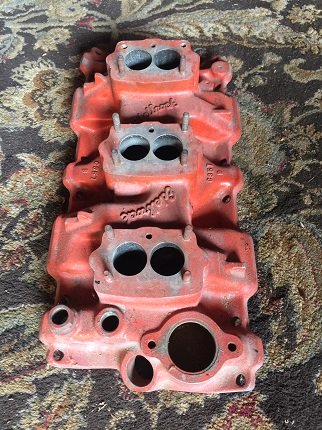Chevy Small Block History 1955-1959
Article by Mark Trotta
All classic V8 engines had performance potential, but early Chevy V8's had more performance potential right out of the box. This was largely due to it's already good breathing characteristics, coupled with the availability of both factory and aftermarket performance parts. Plus, interchangeability of parts (cylinder heads, intake and exhaust manifolds, etc) is second to none!
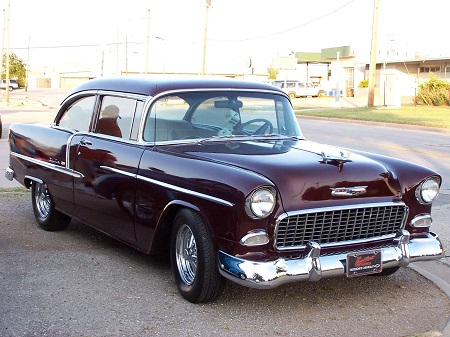
First Chevy V8
First, let's get a bit of automotive trivia out of the way.
Chevy's first V8 was not the 265 cubic-inch V8 introduced in 1955. Their first V8 was produced in 1917, a 288 cubic-inch overhead valve engine featuring a partially exposed valvetrain and nickel-plated valve covers. It was installed in the D-Series Chevrolet and built in 1917 and 1918 only. With a horsepower rating of 36, neither the motor nor the D-Series were very popular.
265 Small-Block (1955-1957)
In late 1954, Chevy introduced their new "Turbo-Fire" V8, available in 1955 Chevy cars and light-duty trucks. A piston bore of 3.75" and relatively short stroke length of 3.00" (times 8) gave a displacement of 265 cubic-inches. The block was made of cast-iron and featured five main bearings.
The cylinder heads on first-year engines were fitted with 1.72" intake valves and 1.50" exhaust valves. With an 8.00:1 compression ratio and a two-barrel carburetor, the 265 V8 produced 162-horsepower.
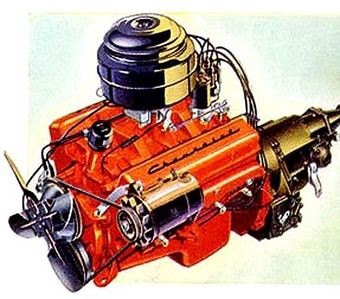
The small-block Chevy V8 was an immediate success. Soon after, a second, higher-output version was offered. With the addition of a four-barrel carb and some minor tweaking, power output increased to 180 horsepower.
Zora Arkus Duntov
When Zora Arkus Duntov was assigned to the Corvette in 1955, he was determined to upgrade it's performance and handling.
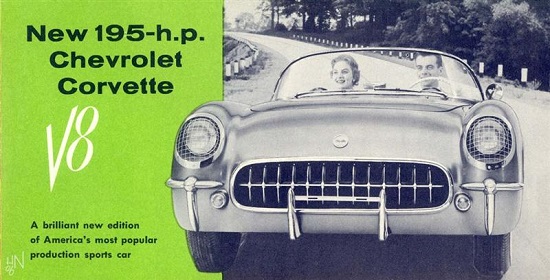
With a Duntov-designed camshaft and some minor tuning, output of the 265 rose to 195 horsepower. That was 30 horsepower more than the standard 265ci engine.
********************
1956 Chevy Small-Block
First-year SBC's did not have an oil filter nor a provision for one. An external filter canister, mounted atop the thermostat housing, was optional.
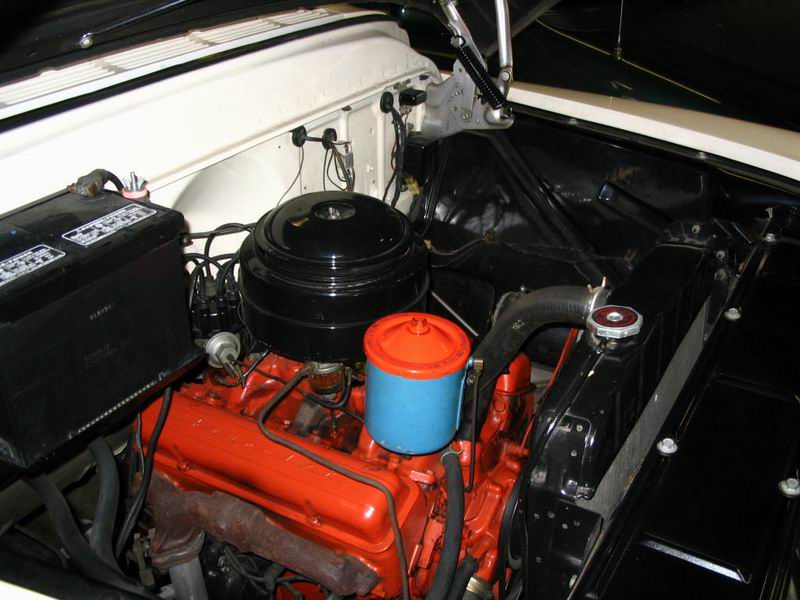
Beginning in 1956, small-blocks were machined to include a block-mounted cartridge oil filter.
********************
1956 Chevy Engine Options
The 1956 model year started with two versions of the 265ci motor. There was the standard two-barrel motor (165 hp), and a Rochester four-barrel version (210 hp). High-lift cams were soon introduced to capitalize on the free-flowing characteristics of the motor.
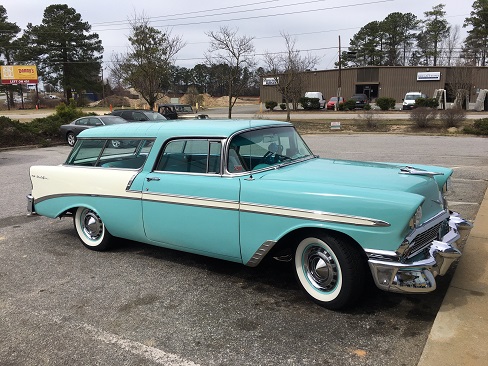
Power-Pack Option
In mid-year, Chevrolet introduced the 265 "Power-Pack" engine. This extra-cost option included dual WCFB Carter four-barrels on an aluminum intake manifold and a mechanical lifter camshaft. With a compression ratio of 9.25:1, the little 265 was now pushing 225 horsepower.
1956 Corvette Engine Choices
A second dual-quad motor, producing 240 horsepower, was offered in the Corvette only. This was achieved by raising engine compression (9.25:1 to 10.3:1) and installing a new high-lift camshaft. The Duntov-designed cam, part #3734077, was a popular item at the Chevy parts counter.
Duntov Camshaft
Another new camshaft featured the same duration as the 077 cam, but lobe lift was reduced slightly. The new cam's part number ended with 097, but is more commonly known as the 'Duntov' cam. This was the camshaft Chevrolet used in all solid-lifter small-blocks from 1957 through 1963.
********************
Valve Cover Bolt Pattern
The first two years of Chevy small-blocks had a slightly different valve cover bolt pattern than 1957 through 1985 engines.
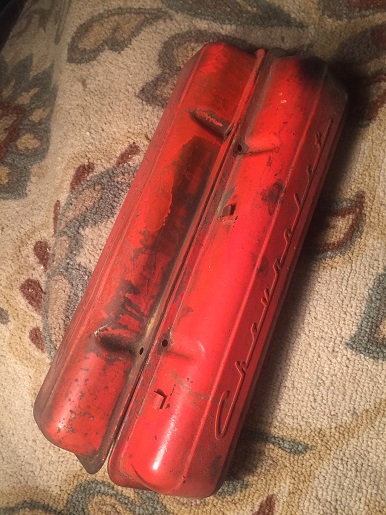
Note that the two upper bolt holes (shown on right cover) are closer together than the bottom two bolt holes (left cover).
**********************
283 Small Block Chevy (1957-1967)
For 1957, Chevrolet engineers increased the cylinder bore of the 265 to 3.88", making a 2nd small-block with a displacement of 283 cubic-inches.
1957-Only Block
When introduced for the 1957 model year, the 283 block did not have side motor-mount bosses (neither did the 265). If you're restoring a 55-56-57 Chevy, these blocks are hard to come by today, although later blocks will also work (1957 engine mounts are on the front of the motor).
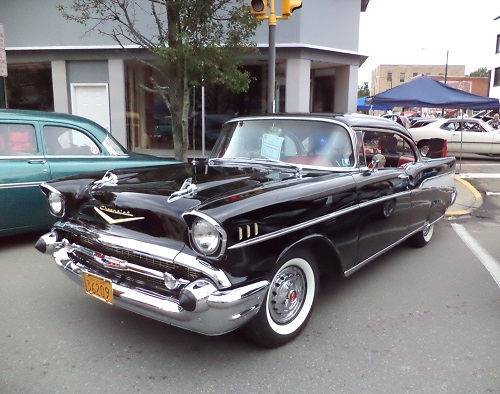
Early 283 motors would use 265 block castings, but it was found that the cylinder walls were too thin to handle the larger displacement. This led to overheating issues on early 283 blocks. A recasting of the block gave thicker cylinder walls, as well as side motor-mount bosses.
All subsequent 283 blocks (1958 through 1968) had side motor-mount bosses, as do all other Gen-One SBC's.
********************
1957 Chevy Engine Options
In addition to the base six-cylinder, there were seven V8 options. These included a 265 with two-barrel carburetor, 283 with two-barrel carburetor, 283 with four-barrel carburetor, 283 with dual quads, or the new "Ramjet" mechanical fuel-injection system.
- 250ci "Blue Flame Six", 140-horsepower
- 265ci "Turbo-Fire" V8 with 2bbl, 162-horsepower
- 283ci V8 with 2bbl, 185 horsepower
- 283ci V8 with 4bbl Carter, 220 horsepower
- 283ci V8 with dual carbs and hydraulic-lifter cam, 245-horsepower
- 283ci "Ramjet" fuel-injection, 250-horsepower
- 283ci V8 with dual carbs and solid-lifter cam, 270-horsepower
- 283ci "Ramjet" fuel-injection, 283-horsepower
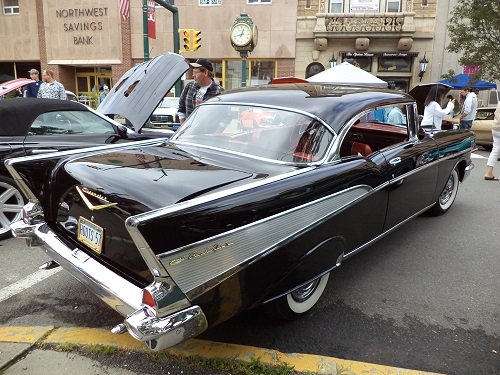
Ramjet Fuel Injection (1957-1965)
In the first year offered, the Rochester-built mechanical fuel injection system (also optional on the 1957 Pontiac Bonneville), was available in two power ratings, 250-hp or 283-hp.
One Horsepower Per Cubic-Inch
The higher output Ramjet fuel injection, producing 283 horsepower, allowed the division to claim "one horsepower per cubic inch". Although Chrysler had achieved this figure with its 1956 300B, Chevrolet capitalized on it, through racing wins and advertising.
Most Ramjet fuel-injected motors were the 250 horsepower, smooth-idle 283, which often powered four-door Bel Airs loaded with optional luxury equipment.
********************
1957 Corvette
The Corvette's base engine was now a 283, available in five versions; 220-hp, 245-hp, and 270-hp carbureted, and 250-hp or 283-hp with Ramjet fuel injection.
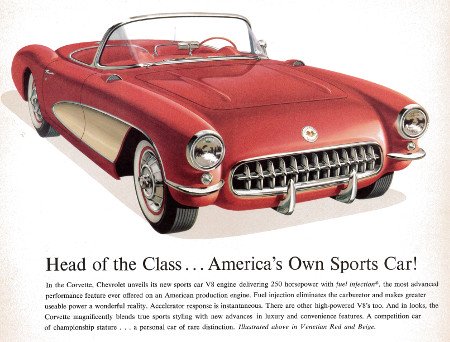
Along with more power, a 4-speed manual transmission was offered for the first time.
********************
1958 Chevy Engine Choices
Many full-size Chevy's (Delray, Biscayne, Bel Air, Impala, and Station Wagons) came standard with a Stovebolt Six, with the 283 V8 optional. A new 348 cubic-inch "W-block" was also available.
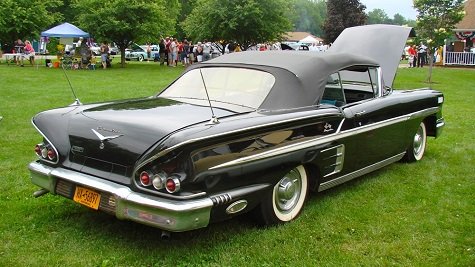
The 1958 Corvette 283 was available in five versions; 230-hp, 245-hp, and 270-hp carbureted, and either 250-hp or 290-hp with Ramjet fuel injection.
********************
1959 Chevy Engine Choices
The 283 was available in all full-size Chevy models (Biscayne, Bel Air, Impala, El Camino). Two versions were offered, a two-barrel carburetor producing 185 horsepower, and the "Super Turbo-Fire" 283 V-8 with a four-barrel carb producing 230 horsepower. Also available was the 348 motor.
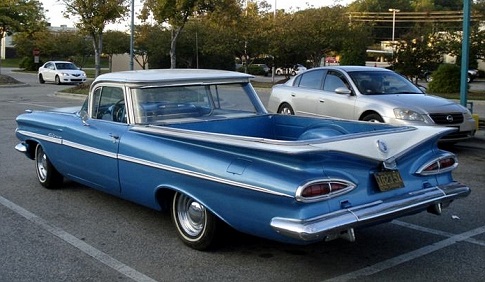
When overall vehicle heights were lowered for 1959, the original oil-bath air filter was replaced by a shorter, wider air filter housing.
The 1959 Corvette 283 was available in same five versions as 1958.
Engine Code Stamping Numbers
All Chevy engines are stamped with an engine ID code, which will include assembly plant code, production date and suffix code. V8 codes are stamped on a pad just forward of the right side (passenger) cylinder head.
********************
Notes and Misc
The Ramjet fuel injection system was complex for it's day and not popular with the general public. Most dealers didn't know how to work on them, and often replaced the system with a carburetor intake system. The Ramjet option was dropped on Chevy passenger cars after 1959, but continued as an option on Corvettes until 1965.
Chevy small block V8's produced from 1955 through 2003 are referred to as Generation One (Gen One) engines. They didn't actually get the "small-block" nickname until Chevy's big-block arrived in 1965.
********************
Articles of Interest:
Chevy Small-Block History 1960-1964
Chevy Small-Block History 1965-1969
327 Chevy Build
Best Heads For Gen-1 Small-Block Chevy
Chevy Stovebolt Six
American Cars of the Fifties
Tools Needed For An Engine Build
